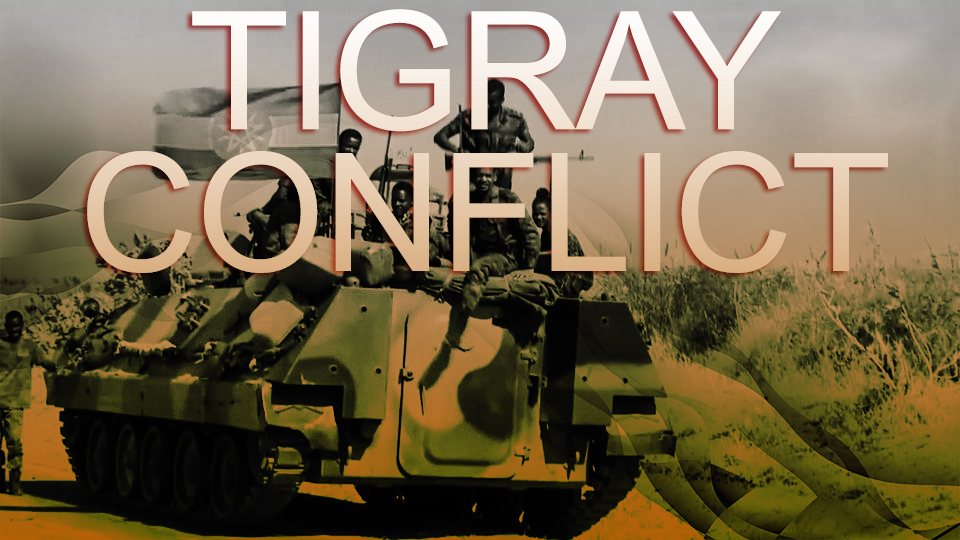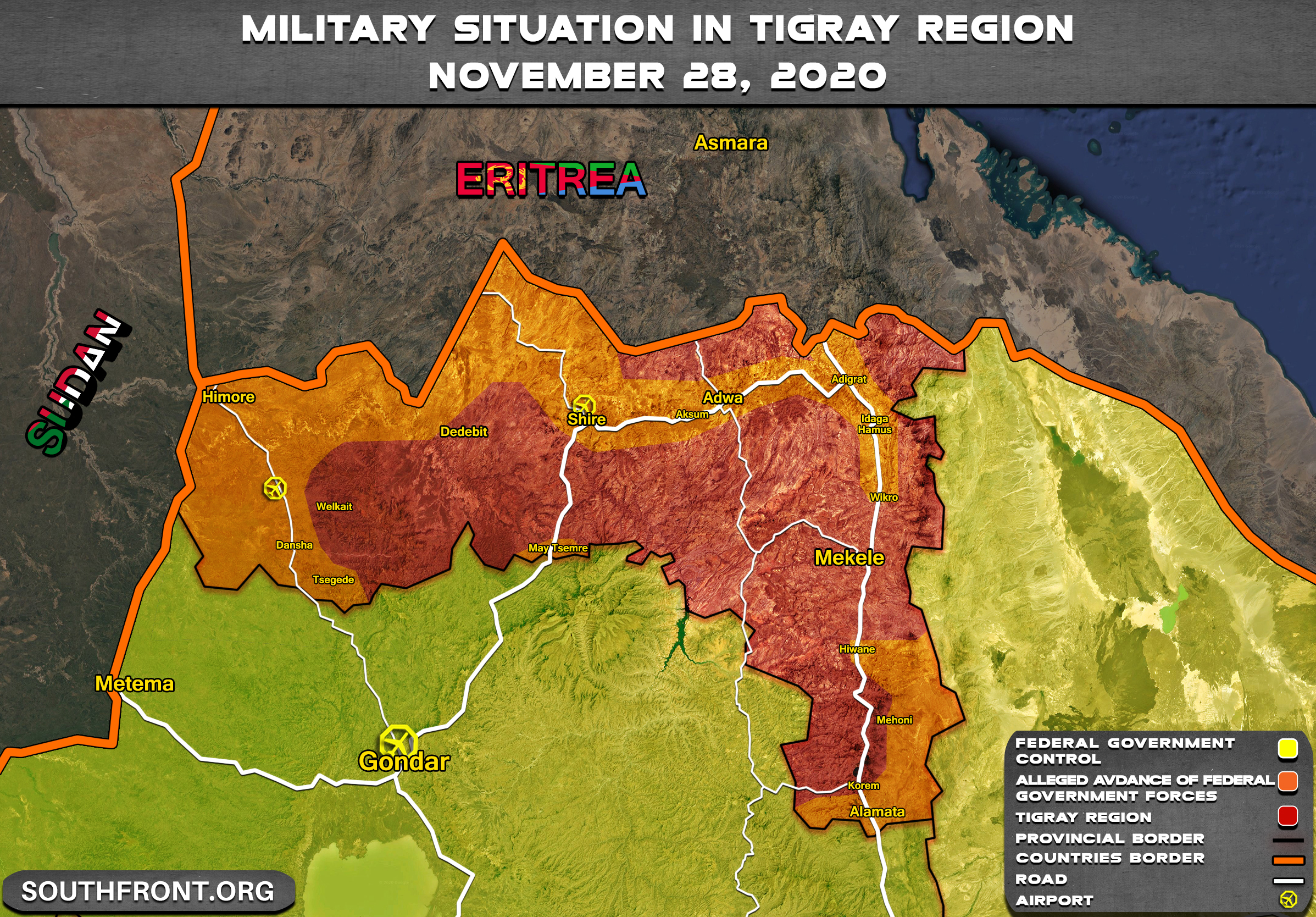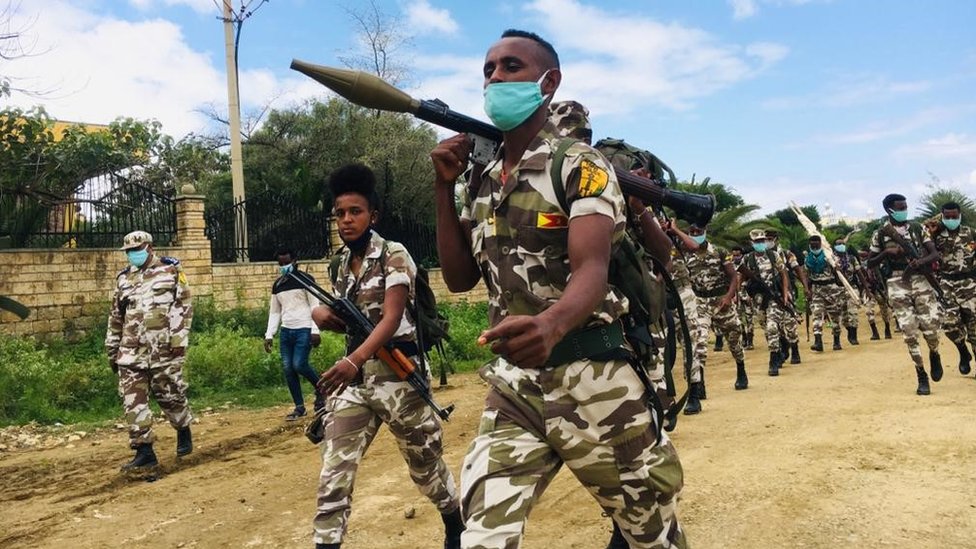Written by Daniel Edgar exclusively for South Front
After eight months of brutal conflict, the Tigray Defence Forces have achieved a series of stunning battlefield victories over the last week that appear to have gutted and expelled a large part of the military forces of the hostile occupying powers (the armed forces of the Ethiopian Federal government, Eritrea and Amhara Regional State ‘security forces’ and militias) from many of the most strategically, demographically, culturally and economically important cities and sub-regions in the heart of Tigray Regional State.
The recaptured areas include the regional capital Mekelle (which was abandoned by the occupying forces and interim administrative regime on Monday 28 June), and the major regional centres of Axum and Shire to the northwest of the capital. (LINK) In the process, the Tigray Defence Forces (TDF) claim to have captured large stocks of weapons and ammunition as well as thousands of prisoners from the occupying forces: preliminary reports and testimony emerging from the region, which has once again been subjected to a complete communications blackout by the Federal government, tend to support these claims.
The TDF is a coalition of local Tigrayan factions (including the former ruling political party, the Tigray People’s Liberation Front or TPLF, as well as several social and political opposition groups) that was formed late last year in order to coordinate their response to the Federal government’s military offensive against the region.
During the preceding weeks, the Tigray Defence Forces reportedly managed to retake several areas to the south of Mekelle that had been captured and held by Ethiopian forces or militias allied with them since last November. On the 23rd of June, the TDF claimed that its air-defence units had shot down a C-130 cargo aircraft of the Ethiopian Air Force (ETAF) near the town of Gijet towards the southeast of Tigray Region, not far from Mekelle. Sources in Tigray shared photos showing the wreckage of the cargo aircraft, one of only two functional C-130 transport aircraft operated by the ETAF. (LINK)
Now confirmed that a C-130 carrying troops and ammunition was shot down by the TDF in the vicinity of Gijet this morning. Images taken from the crash site show that the aircraft was totally destroyed. There are no survivors.
This is the third visually confirmed airframe loss. pic.twitter.com/ugl7tg2wQT— Ethiopia Map (@MapEthiopia) June 23, 2021
It is now increasingly clear that these were preliminary operations designed to prepare the ground for a major military offensive, and that the offensive caught the occupying forces completely unprepared, resulting in the capture or destruction of a large part of their combined military forces and equipment deployed to the Tigray region and the hasty retreat of the remaining forces to more peripheral areas to the north (in the case of Eritrean military forces) or the south and west (in the case of the Federal government’s military units and the security forces and militias from neighbouring Amhara Regional State).
It has been reported that the Eritrean military forces are hastily preparing fortifications in the north of Tigray, where they will attempt to establish a new front line while they regroup and replenish their arsenals, as well as preparing a second line of trenches and fortifications all along the border in case the first line of fortifications are overrun.
There is in effect zero reliable information as to the location, condition and intentions of the remaining Federal military units, though it now seems certain that their operational and fighting capabilities have been severely degraded. This would explain Prime Minister Abiy’s recent declaration of a unilateral ceasefire after eight months of stubborn insistence on a military conclusion to his ‘law enforcement operation’, in which the only acceptable outcome was the capture, summary execution or unconditional surrender of the Tigrayan political and military leadership and the imposition of an ‘interim regional administration’ by the Federal government.
Nonetheless, at this point the extent of the Federal losses remains uncertain, for while it appears that it may well have lost the war, the Federal government is still very effective at maintaining a complete information blackout on ongoing developments and inventing what appear to be increasingly delusional cover stories. Yesterday the New York Times reported:
“In his first comments since Ethiopia suddenly ended its military operation in the northern region of Tigray, Prime Minister Abiy Ahmed said that his army units had been ambushed and ‘massacred’ while passing through villages, but that any claims that his military had been defeated were ‘a lie’. …
He spoke to an applauding crowd in a hotel ballroom in the capital, Addis Ababa, on Tuesday. A videotape of the address was posted online on Wednesday…
The Ethiopian government … asserted that it had voluntarily withdrawn its forces in a unilateral cease-fire, for humanitarian reasons, to allow crops to be planted.
“Enemy claims that it forced the military to leave by hitting back and defeating us is a lie,” Mr. Abiy said in his address. “When an enemy disseminates fake news and media outlets give credence to it and multiplies it, that becomes a problem.” LINK
Will the series of major, if not crushing, battlefield defeats finally persuade the prime minister to seek a negotiated end to the conflict, or will he continue on the path of destruction of the social, cultural and economic fabric of Ethiopia beyond the point of no return? That point may have already been crossed, but it might yet be possible to initiate a process of negotiation, stabilization and national reconciliation if decisive action is taken.
If Abiy persists on his ruinous path, will his political allies and associates finally get rid of him and seek a leader (or leaders) that may be capable of edging the country away from the abyss it is plummeting into? If not, Ethiopia will probably cease to exist within a relatively short period of time, to be replaced by a group of primarily ethnically-based statelets which will be ravaged by internecine armed conflicts with their neighbours for many years to come.
While it may seem to be an anachronism that Abiy would be deposed when his recently formed ‘Prosperity Party’ is set to sweep to a resounding victory in the recent national elections and claim almost all of the seats in the Federal parliament, it is less so when one takes into account that all viable political opponents have been systematically imprisoned (and more than a few assassinated) over the last year, and their operational headquarters and regional branches occupied and sealed off by Federal and State ‘security forces’, in apparent imitation of the ruling methods in neighbouring Eritrea, widely recognized as one of the most authoritarian and oppressive regimes in the world.

Members of Amhara region militias ride on their truck as they head to face the Tigray People’s Liberation Front (TPLF), in Sanja, Amhara region near a border with Tigray, Ethiopia November 9, 2020. REUTERS/Tiksa Negeri
In this context, some of the factors that will be crucial to determining the future course of the conflict include the following:
** Will the TDF be able to withstand and counter the inevitable waves of aerial strikes that will follow (assuming that Prime Minister Abiy and his associates continue to refuse to submit to reason and seek a negotiated settlement to end the conflict and initiate a sustained process of regional and national reconciliation)?
Although reliable information remains extremely scarce, it appears that the Ethiopian Air Force relied heavily on drone strikes to smash the Tigrayan defences and heavy weapons systems in the first stages of the conflict, reports suggesting several possible sources – flights launched from neighbouring Eritrea (possibly involving drones operated by the UAE), others reports implicating Chinese-made drones (and/ or drones acquired from other sources), operated presumably by the Ethiopian Air Force.
** Will the TDF leadership take heed of some of the obvious mistakes of the commanders of the occupying forces, and treat all prisoners humanely as well as, critically, all civilians living in re-captured areas. This is most important in the areas that have been taken over by Amhara armed groups and other disputed border areas, where the leadership and field commanders of the Tigrayan forces will have to be alert and vigilant to ensure that there are no revenge killings and mistreatment of civilians caught in conflict zones. This will be imperative if the situation is to be stabilized.
** Although the Tigrayan leadership has stated it will not hesitate to launch military actions beyond the Tigray region if necessary to guarantee that no future aggression will be conducted against their territory and people, they must realize that this would be extremely risky as apart from the logistical difficulties, it would risk unifying and reinvigorating the Federal, Eritrean and Amhara forces and people to continue the conflict against Tigray as nothing else could.
It would also leave very few armed forces to secure the Tigray region against the ongoing occupation of much of Tigray’s territory by hostile forces and to prevent future efforts to re-invade the region, or simply to conduct harassment and sabotage operations to obstruct and disrupt social and economic recovery efforts. The response of the Federal and Eritrean political and military leadership to the latest developments will be crucial in this respect: if they continue to attack and disrupt recovery efforts within Tigray Regional State, they will leave the Tigrayan leadership with no alternative but to attempt to neutralize all hostile forces and their operating and support bases wherever they may be located.
** Will the Tigray leadership invite, or at least allow, relatively unrestricted access by the ‘international community’ to the Tigray region (1) for humanitarian purposes and to restore damaged, destroyed or looted infrastructure and essential services, economic and agricultural installations and equipment, (2) in order to contribute to the initiation and conduct of detailed investigations into all allegations of war crimes and crimes against humanity and related matters. While Tigrayans have very little to thank the international community for after the last year, and have every reason to be mistrustful in many cases, it is likely that they will be eager to re-establish contact with the outside world and receive all types of assistance possible to begin the difficult task of recovering from the immense destruction and suffering.
** Given that access to the Tigray region is only possible from Ethiopia, Eritrea or Sudan (and that the latter is far removed from the main demographic centres of Tigray and transport routes linking them to the rest of the world), will the Ethiopian Federal government and Eritrean government continue to attempt to keep Tigray isolated and prevent the movement of humanitarian aid into the region and the deployment of international experts and investigators (whether by international organizations, individual countries, widely recognized and accredited civil society organizations, or others).
Based on developments up to now, this is the most likely scenario (i.e., they will attempt to maintain a complete information blackout as well as physical isolation of the region from the rest of the world). In this respect, yesterday’s report by the New York Times stated:
“Two officials with international aid agencies said their work in Tigray is now impeded because the central government had cut electricity, internet and phone lines to the region. Speaking on the condition of anonymity on Tuesday because they were not authorized to comment publicly, they said a colossal effort was now needed to bring lifesaving aid to Tigray.” LINK
If this continues to be the case, what will the leadership in Sudan decide with respect to permitting the movement of people, aid supplies and other goods and services between Sudan and the Tigray region, assuming the Tigray Defence Forces are capable of recapturing and securing the western regions of the province up to the border with Sudan.
** If Sudan decides to permit and facilitate international access to Tigray, would the Federal government of Ethiopia, Eritrean and Amhara Regional State leadership and militias try to prevent such humanitarian corridors and transport routes from being established by armed force? If so, would they be able to? The Federal Armed Forces are clearly severely demoralized and degraded as a viable fighting force, and although it cannot be discounted that they will eventually recover and take back the initiative, the sudden dramatic shift in battlefield developments and territorial control appears to be significantly more than a temporary setback.
Veteran regional analyst Kjetil Tronvol stated of recent developments and their immediate implications for Eritrea and the rest of Ethiopia:
“Ethiopia is blatantly rejecting TDF’s claims of holding the upper hand in the fight. The government spokesperson stated on 3 June that ENDF [Ethiopian National Defence Force] is currently ‘finalizing operations’ to achieve the law enforcement objective to arrest or eliminate the TPLF ‘junta’. However, the TDF counter-offensive ‘Operation Alula,’ launched on 18 June, has reportedly ‘liberated’ swaths of territories and towns across central and eastern Tigray, and thousands of ENDF soldiers are taken as prisoners of war.
From inside Eritrea, an … opposition activist, who must remain anonymous for their safety, conveyed growing sentiments of despair: “The war has a bad impact on the government. Although the people have been losing faith in the government for a while, this will be the final blow for those who were perhaps not as convinced.”
The source also described an environment of ‘mistrust and betrayals’ prevalent within the Eritrean army. He said, “when President Isaias Afwerki tries to escape from taking responsibility for this, it is obvious that it will devastate his chances of staying in power.” LINK
Time is now extremely short if Ethiopia is to have any chance of pulling back from the brink of a violent and irreversible disintegration resulting in widespread and long-running armed conflicts between and within the Regional States of which it is comprised, at least some of which would inevitably draw in other neighbouring States.
Meanwhile, Afwerki’s attempt to wreak vengeance on his long-standing foe, the TPLF, also appears to have backfired in a major way, and poses a similar existential threat to the ruling regime in Eritrea, which could similarly tear what remains of that country apart in their desperate attempt to stay in power at any cost.
MORE ON THE TOPIC:








